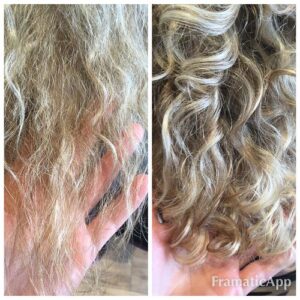Should You Spray on Heat Protectant Before Styling?

Photo by Pawel Czerwinski on Unsplash
When it comes to heat styling your hair, the use of a heat protectant is often a topic of debate among beauty enthusiasts. Understanding the importance of heat protectant and how it works is crucial in making informed decisions for your hair care routine.
Understanding Heat Protectant
Heat protectants are products specifically designed to shield your hair from heat damage caused by styling tools such as curling irons or straighteners. They create a barrier between your hair and the high temperatures produced by these tools, preventing direct heat exposure to your hair shaft.
Importance of Heat Protectant
Using a heat protectant is essential in safeguarding your hair from potential damage. When you apply heat to your hair without protection, it can lead to dry and damaged hair, split ends, and overall deterioration of your hair health.
How Heat Protectants Work
Heat protectants work by forming a protective layer on your hair cuticle, reducing the amount of heat that penetrates the hair shaft. This layer acts as a barrier that helps to maintain the moisture in your hair, preventing it from becoming brittle or prone to breakage.
Types of Heat Protectants
There are various types of heat protectants available on the market, including heat protectant sprays, creams, serums, and oils. Each type offers different levels of protection and benefits suited for various hair types and styling preferences.
Benefits of Using Heat Protectant

Photo by RyanMcGuire on Pixabay
Using a heat protectant offers numerous benefits for your hair, including protecting it from heat damage, keeping it healthy, and preserving your hair color. Incorporating a heat protectant into your styling routine can make a significant difference in the long-term health and appearance of your hair.
Protecting Hair from Heat Damage
A heat protectant forms a shield over your hair, reducing the risk of damage caused by heat styling tools. This protection is particularly important for individuals with fine hair or curly hair that are more susceptible to heat damage.
Keeping Hair Healthy
Regular use of a heat protectant can help keep your hair healthy by preventing moisture loss and maintaining the natural oils in your hair. It strengthens the hair cuticle, making it less prone to breakage and environmental damage.
Preserving Hair Color
If you color your hair, using a heat protectant can help preserve the vibrancy and longevity of your hair color. Heat can accelerate color fading, so incorporating a protectant in your routine can extend the life of your color-treated hair.
Choosing the Best Heat Protectant

Photo by TYMO Beauty on Unsplash
When selecting the best heat protectant for your hair, there are several factors to consider to ensure effective heat protection without weighing down your hair or causing buildup. These factors include your hair type, preferred styling tools, and the level of heat exposure your hair encounters.
Factors to Consider
Consider your hair type when choosing a heat protectant to cater to the specific needs of your hair. Different hair types require varying levels of protection and hydration. Additionally, evaluate the heat settings of your styling tools to select a protectant that can withstand the heat levels you use.
Recommended Products for Different Hair Types
For individuals with fine hair, opt for lightweight heat protectant sprays that provide thermal protection without weighing down the hair. Those with curly hair may benefit from moisturizing heat protectant creams to combat dryness and frizz. Consult with a professional stylist for tailored recommendations based on your hair type.
Application Techniques
Proper application of heat protectant is crucial for maximizing its effectiveness. Begin by applying the protectant to damp, clean hair before using any heat styling tools. Ensure even distribution throughout the hair, focusing on the mid-lengths and ends where damage is most prevalent.
Using Heat Protectant Correctly
Utilizing heat protectant correctly is essential to reap its full benefits and shield your hair from heat damage. By incorporating the following pre-styling preparation steps and application methods, you can enhance the protective features of your heat protectant.
Pre-Styling Preparation
Prior to styling, prepare your hair by washing with a hydrating shampoo and conditioner to maintain hair moisture. Towel-dry your hair or allow it to air dry partially before applying the heat protectant to ensure maximum absorption and protection.
Proper Application Methods
When applying heat protectant, start with a small amount and gradually increase as needed based on your hair length and thickness. Distribute the product evenly by combing through your hair to coat each strand thoroughly. Avoid applying excessive heat protectant, as it can weigh down your hair and hinder styling results.
Combining Heat Protectant with Other Products
For enhanced hair protection and styling benefits, consider combining heat protectant with other products such as leave-in conditioners or hair masks. Layering compatible products can provide added nourishment, humidity resistance, and style longevity while maintaining the protective barrier established by the heat protectant.
Common Misconceptions About Heat Protectant

Photo by murat esibatir on Pexels
When it comes to heat protectants, there are several misconceptions that may influence how people perceive these products. Let’s debunk some common myths to help you make informed decisions when using heat protectant sprays or creams.
Myth: Heat Protectants Make Hair Greasy
Contrary to this belief, not all heat protectants leave a greasy residue on your hair. With the right product and proper application, you can enjoy heat protection without sacrificing the look and feel of your hair.
Myth: All Heat Protectants Provide the Same Level of Protection
It’s essential to note that different heat protectants offer varying levels of protection. Some products are formulated for specific hair types or heat styling tools, so it’s crucial to choose a heat protectant that suits your needs.
Clarifications on Heat Protectant Myths
Understanding the truth behind these myths can help you optimize the benefits of heat protectants. By selecting the right product and using it correctly, you can protect your hair from heat damage without experiencing any unwanted side effects.
DIY Natural Heat Protectant Options
While commercial heat protectants are widely available, you may prefer natural alternatives for your hair care routine. Let’s explore some DIY options that can provide heat protection while nourishing your hair.
Coconut Oil as a Heat Protectant
Coconut oil is a popular natural heat protectant that can help shield your hair from heat damage. Its moisturizing properties can also leave your hair looking shiny and healthy after heat styling.
Aloe Vera Gel for Heat Protection
Aloe vera gel is another natural alternative that offers heat protection and hydration for your hair. Applying aloe vera gel before heat styling can create a protective barrier while adding moisture to your strands.
Other Natural Alternatives
In addition to coconut oil and aloe vera gel, there are other natural ingredients such as shea butter, argan oil, and honey that can act as heat protectants. Experiment with these alternatives to find the best natural heat protectant for your hair.
Signs Your Hair Needs Extra Heat Protection

“MONAT FOR FRIZZY/DRY or DAMAGED HAIR” by Unskinny Boppy is licensed under CC BY 2.0
Understanding when your hair requires additional heat protection is crucial to maintaining its health and vitality. Keep an eye out for signs of heat damage and implement strategies to revive and protect your hair from further harm.
Indications of Heat Damage
If you notice signs such as dryness, brittleness, split ends, or excessive breakage, your hair may be experiencing heat damage. It’s essential to address these issues promptly to prevent further deterioration.
Strategies to Revive Damaged Hair
To revive heat-damaged hair, consider incorporating deep conditioning treatments, trimming split ends, and minimizing heat styling. Opt for gentle hair care practices and nourishing products to restore your hair’s health and resilience.
Preventive Measures for Healthy Hair
Preventing heat damage is key to maintaining healthy hair. Use heat protectants, limit the use of heat styling tools, and embrace natural heat protectant alternatives to safeguard your hair from excessive heat exposure and potential damage.
Frequently Asked Questions about Hair Styling and Heat Protection
What is a heat protectant?
A heat protectant is a product, usually in the form of a spray or cream, that is applied to the hair before using heat styling tools to help protect your hair from heat damage.
Why is it important to use a heat protectant?
It is important to use a heat protectant because heat styling tools can cause damage to your hair like split ends and hair damage. A heat protectant creates a barrier between your hair and the heat, protecting your hair and keeping it healthy.
How does a heat protectant work?
A heat protectant works by forming a protective barrier between your hair and the heat from styling tools, prevent heat damage and keep your hair looking and feeling its best.
Can I use heat protectant on wet hair?
It is recommended to apply a heat protectant on damp hair before using any heat styling tools to protect your hair from heat and ensure the product is evenly distributed.
What are some tips for choosing the best heat protectant?
Look for a heat protectant that suits your hair type and offers benefits of using a heat protectant like preventing heat damage and keeping your hair looking healthy. You can also opt for natural heat protectants for a more organic approach.
When should I reapply heat protectant?
If you are restyling your hair or exposing it to high heat multiple times, it’s a good idea to reapply heat protectant before each heat styling session. This will help to ensure that your hair is adequately protected from the heat and prevent damage. It’s also a good idea to reapply heat protectant if you have been outside in the sun for an extended period of time or if your hair gets wet, as these can also cause damage to the hair when heat styling. Ultimately, it’s best to use your judgment and apply heat protectant as needed to keep your hair safe and healthy.

